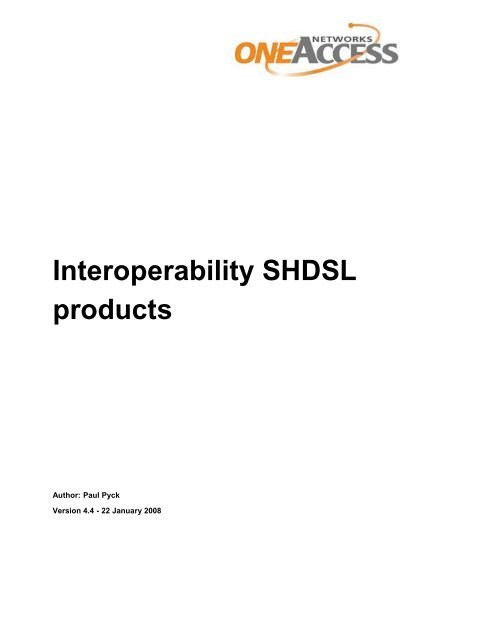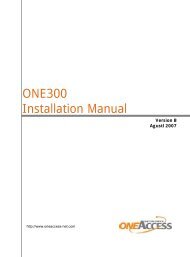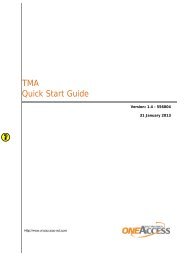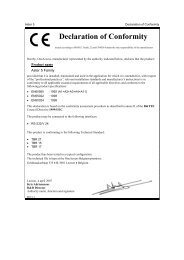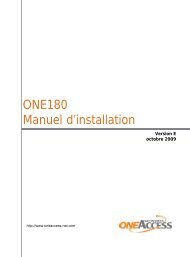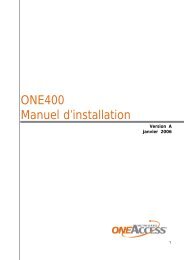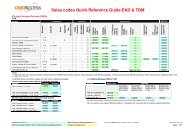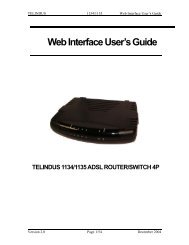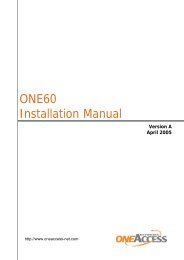Interoperability SHDSL products - OneAccess extranet
Interoperability SHDSL products - OneAccess extranet
Interoperability SHDSL products - OneAccess extranet
Create successful ePaper yourself
Turn your PDF publications into a flip-book with our unique Google optimized e-Paper software.
<strong>Interoperability</strong> <strong>SHDSL</strong><strong>products</strong>Author: Paul PyckVersion 4.4 - 22 January 2008
<strong>Interoperability</strong> <strong>SHDSL</strong> <strong>products</strong>Table of Contents1. INTRODUCTION .......................................................................................................................................... 32. TDM VERSUS BROADBAND DE VICES ........................................................................................................... 33. CROCUS <strong>SHDSL</strong> TT AND TWIN-CV BU .................................................................................................... 64. CROCUS <strong>SHDSL</strong> G703 / RS530 TT.......................................................................................................... 75. CROCUS <strong>SHDSL</strong> REPEATER ..................................................................................................................... 86. CROCUS <strong>SHDSL</strong> 2P INF REPEATER ......................................................................................................... 87. CROCUS <strong>SHDSL</strong> QUAD-CV AND 2300 <strong>SHDSL</strong> SERIES ............................................................................ 98. 142X CPES AND TDM PRODUCTS ........................................................................................................... 109. ONEACCESS CPES AND BROADBAND PROD UCTS...................................................................................... 1110. 143X <strong>SHDSL</strong> CPE................................................................................................................................. 1211. 2400 SERIES .......................................................................................................................................... 1212. USER SPEED INTEROPERA BILITY............................................................................................................... 12File historyDate Revision Changes26 February 2007 4.2 Added TDM interoperability for the 142327 September 2007 4.3 Included 1432 and ONExxx <strong>products</strong>Adapted TDM interoperability for 1423 versions22 January 2008 4.4 Corrected 2300 interoperability with repeatersIntroduced interoperability for Crocus <strong>SHDSL</strong> 2P INF Repeater<strong>OneAccess</strong> Version 4.4 - 22 January 2008 2 / 14
<strong>Interoperability</strong> <strong>SHDSL</strong> <strong>products</strong>1. IntroductionThere are many questions on the interoperability between the different <strong>SHDSL</strong> p roducts <strong>OneAccess</strong> has inits portfolio and their interoperability with DSLAMs. This document gives an overview of the interoperability.Products considered in this document are:Crocus <strong>SHDSL</strong> TT and TWIN -CV BU (with modular interfaces)Crocus <strong>SHDSL</strong> G703 TT (including RP versions)Crocus <strong>SHDSL</strong> RS530 TT (including RP versions)Crocus <strong>SHDSL</strong> QUAD-CVCrocus <strong>SHDSL</strong> RepeaterCrocus <strong>SHDSL</strong> 2P INF Repeater1420 <strong>SHDSL</strong> Router1421 <strong>SHDSL</strong> Router1422 <strong>SHDSL</strong> Router1423 <strong>SHDSL</strong> Router (several versions)1431 <strong>SHDSL</strong> CPE1432 <strong>SHDSL</strong> CPE2300 <strong>SHDSL</strong> Series2400 SeriesONE60ONE80ONE180ONE200ONE300ONE400Different sections are present per product or product group. First of all, a distinction is made betweendevices made for TDM and those made for broadband applications.2. TDM versus broadband devices<strong>SHDSL</strong> devices can be divided into 2 categories: de vices for TDM networks and devices for broadbandnetworks. In general, devices for TDM networks are interoperable with each other and devices for broadbandnetworks are interoperable with each other. Some devices can be used for both networks. In the list belowboth 1 pair and 2 pair versions are included.ProductCrocus <strong>SHDSL</strong> TT and TWIN -CV BU (with modular interfaces)Crocus <strong>SHDSL</strong> G703 TT / Crocus <strong>SHDSL</strong> RS530 TT (including RP versions)Crocus <strong>SHDSL</strong> QUAD-CVCrocus <strong>SHDSL</strong> RepeaterCrocus <strong>SHDSL</strong> 2P INF RepeaterSuitablefor TDMSuitable forbroadband1420 <strong>SHDSL</strong> Router (obsolete) 1421 <strong>SHDSL</strong> Router 1422 <strong>SHDSL</strong> Router 1423 <strong>SHDSL</strong> / 1423 <strong>SHDSL</strong> 2ETH-4P / 1423 <strong>SHDSL</strong> 2ETH-4P HWA <strong>OneAccess</strong> Version 4.4 - 22 January 2008 3 / 14
<strong>Interoperability</strong> <strong>SHDSL</strong> <strong>products</strong>1423 <strong>SHDSL</strong> 2ETH-4P ISDN HWA 1431 <strong>SHDSL</strong> CPE 1432 <strong>SHDSL</strong> CPE 2300 <strong>SHDSL</strong> Series 2400 Series ONE60ONE80ONE180ONE200ONE300ONE400The main differences between <strong>products</strong> for TDM networks and <strong>products</strong> for broadband networks are thefollowing:TDM networks<strong>SHDSL</strong> plesiochronous m odeMany clocking optionsEither the product is transparent for layer 2 or a variety oflayer 2 protocols (HDLC, PPP, Frame Relay, ATM)Broadband networks<strong>SHDSL</strong> synchronous mode Clocking slaved on networkLayer 2 is ATMThe next table gives a quick interoperability overview. Boxes in green mean that new equipment isinteroperable without real restrictions. Yellow means there are some restrictions (e.g. on speed options). Redmeans no interoperability.The next chapters give the details about interoperability. If the drawings mention 1423, all the versions of the1423 except with ISDN-BRI backup are meant.<strong>OneAccess</strong> Version 4.4 - 22 January 2008 4 / 14
<strong>Interoperability</strong> <strong>SHDSL</strong> <strong>products</strong>Crocus<strong>SHDSL</strong>TT/CV BUCrocus <strong>SHDSL</strong>TT G703 /RS530Crocus<strong>SHDSL</strong>RepeaterCrocus<strong>SHDSL</strong> 2PINF RepeaterCrocus<strong>SHDSL</strong>QUAD2300 1421 &14231422, 1423with BRI,1431, 1432ONExxx 2400Crocus <strong>SHDSL</strong> TT/CV BUCrocus <strong>SHDSL</strong> TT G703 / RS530Crocus <strong>SHDSL</strong> RepeaterCrocus <strong>SHDSL</strong> 2P INF RepeaterCrocus <strong>SHDSL</strong> QUAD23001421 & 14231422, 1423 with BRI, 1431, 1432ONEXXX2400ATM DSLAM<strong>OneAccess</strong> Version 4.4 - 22 January 2008 5 / 14
<strong>Interoperability</strong> <strong>SHDSL</strong> <strong>products</strong>3. Crocus <strong>SHDSL</strong> TT and TWIN -CV BUThe Crocus <strong>SHDSL</strong> BU ve rsions are the Crocus <strong>SHDSL</strong> modems with modular interface slots. They havedifferent application firmware codes depending on the hardware and the loader firmware as shown in thetable below (see also document Crocus <strong>SHDSL</strong> firmware codes).FirmwarecodeHardware 0.X with long servicedown timeHardware 0.X with shortservice down timeHardware 1.XBoot T2135/XXX00 T2135/XXX00 T2140/XXX00Loader T2137/00300 T2137/00400 T2142/XXX00Application T2136/XXX00 T2145/XXX00 T2141/XXX00The Crocus <strong>SHDSL</strong> operates b y default in plesiochronous mode. Plesiochronous mode allows all clockingmodes.The table below shows the use of Crocus <strong>SHDSL</strong> TT and TWIN -CV with other <strong>SHDSL</strong> <strong>products</strong>. In thedrawings always a Crocus <strong>SHDSL</strong> (2P) TT is shown. Unless explicitly mentioned, th is may equally be aCrocus <strong>SHDSL</strong> (2P) TWIN -CV. Default values for configuration attributes are not always mentioned in the‘interoperability issues’ column.Set-up<strong>Interoperability</strong> issuesIn general no interoperability issues (see next 2combinations).This combination is possible for PPP and Frame RelayWAN encapsulations. It is not possible in ATM WANencapsulation.Use always plesiochronous mode on Crocus <strong>SHDSL</strong>. Theminimum speed per line pair is 192 kbit/s. As of fir mwareT2141/01300 on Crocus <strong>SHDSL</strong>, lower user speeds (one.g. serial interfaces) are possible.Use always plesiochronous mode on Crocus <strong>SHDSL</strong> andline/eocChannel = itu-G.991.2. Line speeds between192kbit/s (384kbit/s for 2 pairs) and 2Mbit/s.Line speeds between 192 and 2304kbit/s per line pair.Operates in plesiochronous and synchronous modes.Use always plesiochronous mode on Crocus <strong>SHDSL</strong>. Theminimum line pair speed is 192kbit/s. One needs minimumfirmware T2141/01300 for user speeds below 192 kbit/s perline pair.<strong>OneAccess</strong> Version 4.4 - 22 January 2008 6 / 14
<strong>Interoperability</strong> <strong>SHDSL</strong> <strong>products</strong>On the Crocus <strong>SHDSL</strong> configure the following:line/region = annexAline/eocChannel = proprietaryGeneral requirements: One needs at least firmware releaseT2136/00800, T2145/00100 or T2141/00100 on the Crocus<strong>SHDSL</strong>. On the Crocus <strong>SHDSL</strong>, configure line /eocChannel= itu-G.991.2.One needs firmware release T2852/00600 on the 1421. Onthe 1421 and 1423 configure line/timingMode =plesiochronous .The line speed is between 192 and 2048 kbit/s. For 2Poperation with G703 interface or external clock, one need sminimum firmware release T2141/00300 on Crocus<strong>SHDSL</strong>.User speeds below 192 kbit/s per line pair are onlysupported starting from firmware release T2852/02100 ofthe 1421.Notes:This combination does not work when a Crocus Router10M Interface is used on the Crocus <strong>SHDSL</strong> and ATMWAN encapsulation is configured over the link.The 1421 and 1423 do not support RDL requests(Crocus <strong>SHDSL</strong> with router interface does).If the interface module on the Crocus <strong>SHDSL</strong> is not aG703 interface, one can also select line /timingMode =synchronous on both devices. In that case, the fullspeed range is available.4. Crocus <strong>SHDSL</strong> G703 / RS530 TTThe Crocus <strong>SHDSL</strong> G703 TT and Crocus <strong>SHDSL</strong> RS530 TT are the Crocus <strong>SHDSL</strong> versions with integrateduser interfaces. They operate always in plesiochronous mode. Line speeds are limited between 192 and2048 kbit/s per line pair.The table below shows the use of Crocus <strong>SHDSL</strong> G703 / RS530 TT with other <strong>SHDSL</strong> <strong>products</strong>. Defaultvalues for configuration attributes are not always mentioned in the ‘interoperability issues’ column.Set-up<strong>Interoperability</strong> issuesUse always plesiochronous mode on Crocus <strong>SHDSL</strong>. Linespeed between 192kbit/s (384 kbit/s for 2 pairs) and2Mbit/s. As of firmware T2141/01300 on Crocus <strong>SHDSL</strong>,lower user speeds (on e.g. se rial interfaces) arepossible.per line.Use always line/eocChannel = itu-G.991.2. Line speedsbetween 192kbit/s (384kbit/s for 2 pairs) and 2Mbit/s.<strong>OneAccess</strong> Version 4.4 - 22 January 2008 7 / 14
<strong>Interoperability</strong> <strong>SHDSL</strong> <strong>products</strong>Line speeds between 192 and 2304kbit/s per line pair.Operates in plesiochronous and synchronous modes.Line speed between 192kbit/s (384 kbit/s for 2 pairs) and2Mbit/s. On serial interfaces lower user speeds arepossible.On the Crocus <strong>SHDSL</strong> G703 / RS530 TT configure thefollowing:line/region = annexAline/eocChannel = proprietaryLine speeds between 192 and 2048 kbit/s (1 pair only).On the 1421 / 1423, configure line/timingMode =plesiochronous.Line speeds between 192 (384 for 2 pairs) and 2048 kbit/s.As of firmware T2148/00400 on Crocus <strong>SHDSL</strong> G703 TT,all firmware of Crocus <strong>SHDSL</strong> RS530 TT and 1423 andfirmware 2852/02100 on the 1421, lower user speeds arepossible.5. Crocus <strong>SHDSL</strong> RepeaterThe figure below shows in which combinations the Crocus <strong>SHDSL</strong> Repeater can be used.In all cases the central and remote units need to be configured in plesiochronous mode. In order to havemanagement over the EOC channel available, one needs to configure line/eocChannel = itu-G.991.2.Several repeaters can be put in cascade (not shown in the figure).Note: another document describes the possibilities with remote powering.6. Crocus <strong>SHDSL</strong> 2P INF RepeaterThe figure below shows in which combinations the Crocus <strong>SHDSL</strong> 2P INF Repeater can be used.<strong>OneAccess</strong> Version 4.4 - 22 January 2008 8 / 14
<strong>Interoperability</strong> <strong>SHDSL</strong> <strong>products</strong>The Crocus <strong>SHDSL</strong> 2P INF Repeater support s 14XX devices in PPP, Frame Relay, HDSL and ATM modes.It operates also in synchronous and plesiochronous modes. All line speeds from 192kbps up to 2304kbpsper line pair are supported. Several repeaters can be put in cascade (not shown on the figure).7. Crocus <strong>SHDSL</strong> QUAD-CV and 2300 <strong>SHDSL</strong> SeriesThe table below shows the use of Crocus <strong>SHDSL</strong> QUAD -CV and 2300 <strong>SHDSL</strong> Series with other <strong>SHDSL</strong><strong>products</strong>. The 2300 <strong>SHDSL</strong> Series and the Crocus <strong>SHDSL</strong> QUAD -CV both are always use as centralmodems!Set-up<strong>Interoperability</strong> issuesThe Crocus <strong>SHDSL</strong> must be configured inplesiochronous mode (default) andline/eocChannel = itu-G.991.2.The minimum line pair speed is 192 kbit/s. Userspeeds (or # G704 time slots) below 192 kbit/sper line pair are only supported as of firmwareT2141/01300 Crocus <strong>SHDSL</strong> and firmwareT2148/00400 on Crocus <strong>SHDSL</strong> G703.The line speed is in the range 192 kbit/s –2Mbit/s (1P only). Only possible with the Crocus<strong>SHDSL</strong> QUAD.Only possible with the Crocus <strong>SHDSL</strong> QUAD.The 1421 / 1423 must be configured inplesiochronous mode.The minimum line pair speed is 192 kbit/s. Userspeeds below 192 kbit/s per line pair are onlysupported starting from firmware releaseT2852/02100 of the 1421.The Crocus <strong>SHDSL</strong> QUAD has additional cl ocking restrictions: this card operates only with one networkclock. This master clock comes from one of the E1 interfaces or from the station clock. The application at theremote side of the <strong>SHDSL</strong> link must be in slave receive clocking mode.<strong>OneAccess</strong> Version 4.4 - 22 January 2008 9 / 14
8. 142X CPEs and TDM <strong>products</strong><strong>Interoperability</strong> <strong>SHDSL</strong> <strong>products</strong>The table below shows the use of the following CPEs with TDM <strong>products</strong>:1421 <strong>SHDSL</strong> Router (including 3DES versions)1423 <strong>SHDSL</strong>1423 <strong>SHDSL</strong> 2ETH-4P1423 <strong>SHDSL</strong> 2ETH-4P HWAImportant note: The 1423 <strong>SHDSL</strong> and 1423 <strong>SHDSL</strong> 2ETH -4P versions support the HDLC, PPP and FrameRelay protocols on the <strong>SHDSL</strong> interface and accordingly are interoperable with TDM <strong>products</strong> as of PCB 0.1Level 3 hardware and T2863/00700 firmware. The 1423 <strong>SHDSL</strong> 2ETH -4P ISDN-2BRI HWA version NEVERcan be used with a TDM product at th e other side of the line.Set-up<strong>Interoperability</strong> issuesGeneral requirements: One needs at least firmwarerelease T2136/00800, T2145/00100 or T2141/00100 onthe Crocus <strong>SHDSL</strong>. On the Crocus <strong>SHDSL</strong>, configureline/eocChannel = itu-G.991.2.On the 1421 / 1423 configure line/timingMode =plesiochronous.The line speed is between 192 and 2048 kbit/s per linepair. For 2P operation with G703 interface or externalclock, one needs minimum firmware release T2141/00300on Crocus <strong>SHDSL</strong>.Notes: One needs minimum firmware release T2852/00600on the 1421.This combination does not work when a CrocusRouter 10M Interface is used on the Crocus <strong>SHDSL</strong>and ATM WAN encapsulation is configured over thelink. In case of a serial or LAN interface on Crocus<strong>SHDSL</strong>, one can also configure synchronous timingmode. In that case line pair speeds between 64 and2304kbit/s are possible.On the 1421 / 1423, configure line/timingMode =plesiochronous.Line between 192 (384 for 2P) and 2048 kbit/s. Userspeeds below 192kbit/s per line pair as of firmwareT2148/00400 on Crocus <strong>SHDSL</strong> G703 and T2852/02100on the 1421.Only possible with 1421 / 1423 as remote unit. On the1421 / 1423, configure line/timingMode = plesiochronous.Line and user speeds are between 192 and 2048 kbit/s.<strong>OneAccess</strong> Version 4.4 - 22 January 2008 10 / 14
<strong>Interoperability</strong> <strong>SHDSL</strong> <strong>products</strong>The 1421 / 1423 must be configured in plesiochronousmode and line/eocChannel = itu-G.991.2 (default).The minimum line pair speed is 192 kbit/s per li ne pair.User speeds below 192 kbit/s per line pair are onlysupported starting from firmware release T2852/02100 ofthe 1421.On the 1421 / 1423, configure line/timingMode =plesiochronous.Notes:9. <strong>OneAccess</strong> CPEs and broadband <strong>products</strong>The table below shows the use of the following CPEs with broadband <strong>products</strong>:Set-up1421 <strong>SHDSL</strong> Router (including 3DE S versions)1422 <strong>SHDSL</strong> Router1423 <strong>SHDSL</strong> Router1423 <strong>SHDSL</strong> 2ETH-4P1423 <strong>SHDSL</strong> 2ETH-4P HWA1423 <strong>SHDSL</strong> 2ETH-4P ISDN-BRI HWA1431 <strong>SHDSL</strong> CPE (for Ethernet traffic)1432 <strong>SHDSL</strong> CPEONE60ONE80ONE180ONE200ONE300ONE400 Management happens over IP, not over the EOCchannel.This combination is possible, starting from firmwarerelease T2852/00600 on 1421.<strong>Interoperability</strong> issuesUse line/timingMode = synchronous (default) and ATMencapsulation (default).14XXONExxx14XXONExxx14XXONExxxDSLAMThis combination is generally possible, both with ATMand Ethernet based DSLAMs. See document ‘S(H)DSLCPE - DSLAM <strong>Interoperability</strong> overview’ for detailedinformation on interoperability tests that have been donebetween 14XX <strong>products</strong> and specific DSLAMs.<strong>Interoperability</strong> includes as well the 2400 Series <strong>SHDSL</strong><strong>OneAccess</strong> Version 4.4 - 22 January 2008 11 / 14
<strong>Interoperability</strong> <strong>SHDSL</strong> <strong>products</strong>versions.10. 143X <strong>SHDSL</strong> CPEThis section defines interoperability of the 1431 and 1432 <strong>SHDSL</strong> CPEs for its specific InterworkingFunctions (IWF) ATM CES, FRF.5, FRF.8 and ATM switching (ATM over E1).Set-up<strong>Interoperability</strong> issuesUse line/timingMode = synchronous (default) and ATMencapsulation (default).143X143X143XATM DSLAMInteroperable for CES, FRF and ATM over E1 with ATMDSLAMs (not with Ethernet DSLAMs). See document‘S(H)DSL CPE - DSLAM <strong>Interoperability</strong> overview’ fordetailed information on interoperability tests that havebeen done with specific DSLAMs.11. 2400 SeriesSet-up<strong>Interoperability</strong> issuesInteroperable2400 Series142X2400 Series143XInteroperable for CES, FRF and ATMover E1 if the 2400 Series is configuredin ATM switching mode. For Ethernettraffic, always interoperable. Especiallyfor CES traffic, the 2400 does notsupport ATM QoS. Therefore thiscombination is to be avoided.In general interoperable with ADSL resp.<strong>SHDSL</strong> CPEs with ATM encapsulationover the line.2400 SeriesOther DSL CPEs12. User speed interoperabilityThe <strong>SHDSL</strong> recommendation defines line pair speeds between 192 and 2312kbit/s. The <strong>OneAccess</strong> devicessupport the 64Kbit/s multiples (except 2312kbit/s on the 1431 and 2400 Series). On some devices also lower<strong>OneAccess</strong> Version 4.4 - 22 January 2008 12 / 14
<strong>Interoperability</strong> <strong>SHDSL</strong> <strong>products</strong>line speeds are supported. On some devices the user and line speeds may be different when operating inplesiochronous mode.The table below shows the different combinations of possible user speeds for central and remote units. Theuser speeds are indicated with value N. N is a 64kbit/s multiple (e.g. N = 32 = 2048kbit/s). A line speeddifferent from the user speed is only possible starting from a firmware revision as listed in the table below. Insome cases this adds extra user speeds, which are put in bold.DeviceCrocus <strong>SHDSL</strong> TT & TWIN-CV BUCrocus <strong>SHDSL</strong> G703 TT (RP)Minimum firmware version for Nx64K operationT2141/01500 using attribute minLinePairSpeed (value different from)T2148/00400 using attribute minLinePairSpeed (value different from)1421 <strong>SHDSL</strong> Router T2852/02100: Use minSpeed = maxSpeed = 64kbit/s or 128kbit/srespectively to obtain a user speed of 64 resp. 128kbit/s at a linespeed of 192kbit/s. Similarly on a 2P version use minSpeed2P =maxSpeed2P = 128kbit/s or 256kbit/s to obtain a user spe ed of 128resp. 256kbit/s at a line speed of 384kbit/s. For other values the userand line speeds are the same.The cells in grey have few practical use. This does not mean the devices cannot operate in this way ascentral or remote units.<strong>OneAccess</strong> Version 4.4 - 22 January 2008 13 / 14
<strong>Interoperability</strong> <strong>SHDSL</strong> <strong>products</strong>1 Pair versionsCentral deviceRemote deviceCr <strong>SHDSL</strong> +serial/router ifCr <strong>SHDSL</strong> + G703Nx64KCr <strong>SHDSL</strong>G703 (RP)Crocus <strong>SHDSL</strong> + DualPort if421 / 1423 inplesiochronous modeCrocus <strong>SHDSL</strong> + serial/router if N = 1…36 N = 1…32 N = 1,2,3…32 N = 1,2,3…32Crocus <strong>SHDSL</strong> + G703 Nx64K N = 1…32 N = 1,2,3…32 N = 1,2,3…32 N = 1,2,3…31* N = 1,2,3…32Crocus <strong>SHDSL</strong> G703 (RP) N = 1,2,3…32 N = 1,2,3…32 N = 1,2,3…32 N = 1,2,3…31* N = 1,2,3…32Crocus <strong>SHDSL</strong> + G703-Serial DPN = 1,2,3…32*Crocus <strong>SHDSL</strong> QUAD N = 1,2,3…32 N = 1,2,3…32 N = 1,2,3…32 N = 1,2,3…31* N = 1,2,3…322300 <strong>SHDSL</strong> N = 1,2,3…32 N = 1,2,3…32 N = 1,2,3…32 N = 1,2,3…31* N = 1,2,3…32* N is the sum of time slots (64kbps) for both the G703 and serial interface. There is at least 1 time slot in use for the G703 interface. The time slots on the centralG703 destined for the G703 on the remote DP interface have the lowest time slot values.2 Pair versionsCentral deviceRemote deviceCrocus <strong>SHDSL</strong> +serial/router ifCrocus <strong>SHDSL</strong> +G703 Nx64KCrocus <strong>SHDSL</strong>G703 (RP)Crocus <strong>SHDSL</strong> + DualPort if1421 / 1423 inplesiochronous modeCrocus <strong>SHDSL</strong> + serial/router if N = 2…72 (N = even) N = 2…32 (N = even) N = 1…4,5…32 N = 2,4,6…32 (N = even)Crocus <strong>SHDSL</strong> + G703 Nx64K N = 2…32 (N = even) N = 1…4,5…32 N = 1…4,5…32 N = 1…4,5…31* N = 2,4,6…32 (N = even)Crocus <strong>SHDSL</strong> G703 (RP) N = 2,4,6…32 (N = even) N = 1…4,5…32 N = 1…4,5…32 N = 1…4,5…31* N = 2,4,6…32 (N = even)Crocus <strong>SHDSL</strong> + G703-Serial DPN = 1…4,5…32*Crocus <strong>SHDSL</strong> QUAD N = 2,4,6…32 (N = even) N = 1…4,5…32 N = 1…4,5…32 N = 1…4,5…31* N = 2,4,6…32 (N = even)2300 <strong>SHDSL</strong> N = 2,4,6…32 (N = even) N = 1…4,5…32 N = 1…4,5…32 N = 1…4,5…31* N = 2,4,6…32 (N = even)* N is the sum of time slots (64kbps) for both the G703 and seri al interface. There is at least 1 time slot in use for the G703 interface. The time slots on the centralG703 destined for the G703 on the remote DP interface have the lowest time slot values<strong>OneAccess</strong> Version 4.4 - 22 January 2008 14/14


